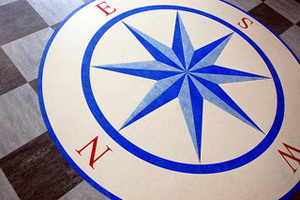Grosso modo or Navigating the Streets of Paris

- SUBSCRIBE
- ALREADY SUBSCRIBED?
BECOME A BONJOUR PARIS MEMBER
Gain full access to our collection of over 5,000 articles and bring the City of Light into your life. Just 60 USD per year.
Find out why you should become a member here.
Sign in
Fill in your credentials below.
 Arnaud, a born and bred Parisian who crosses oceans in sailboats and knows how to read a compass, has rolled his eyes, again. I had begun to tell him that the shortest street in Paris is “not over near the Louvre, but just north…,” and that’s when his eyes rolled and he looked at me as if I were a delinquent recidivist with a pipe-bomb in my hand. The idea of north does not offend him any more than west or east or south by southwest. It’s simply that, more Parisian than sailor, he is exasperated that I refuse to believe that the French do not navigate cities by the cardinal points.
Arnaud, a born and bred Parisian who crosses oceans in sailboats and knows how to read a compass, has rolled his eyes, again. I had begun to tell him that the shortest street in Paris is “not over near the Louvre, but just north…,” and that’s when his eyes rolled and he looked at me as if I were a delinquent recidivist with a pipe-bomb in my hand. The idea of north does not offend him any more than west or east or south by southwest. It’s simply that, more Parisian than sailor, he is exasperated that I refuse to believe that the French do not navigate cities by the cardinal points.
Which is just as well. Urban planning was one of the great ideas of the Enlightenment and has remained an idea in Europe. The escaped Frenchman, Peter Charles L’Enfant—he anglicized his two prénoms as soon as he stepped off the boat—tried it out in Washington and it took: think of all the South Sides and North Ends, uptowns and downtowns all across America. The compass has been the mother and father of the American city, spawning grids, axes, Division Streets and, most of all, how we find our way and give directions.
Arnaud’s rolling eyes proclaim that never in Paris will there be tidy square blocks oriented on a north-south axis or parallel streets or rectilinear intersections—and never includes the past, present and future.* There is as well a subtext in his eyeballs: I should know better, no matter how much time I have spent in the States.
Of course I know better and of course Arnaud is right. If a street actually runs true east to true west in Paris, it is a grave error, in the worst taste, a solecism bordering on lèse majesté. If two streets really are parallel for a hundred metres or so, they won’t remain that way for long. Using American navigation tricks to find your way in Paris will get you lost or turned around and quite possibly take you a long way from where you thought you were going. Perhaps you know this.
But Parisians do find their way pretty well without relying on a compass. They do not do it by knowing all the streets. Paris has 4,936 public streets and about 200 private ones. The cabdrivers rely on GPS, but people who are going somewhere unfamiliar rely on maps to get to the general area and then on the Seine.
 To navigate Paris by this method, there is one thing you must always know and one other thing you must always keep in mind. You must know where you are relative to the Seine and you must remember that words like parallel, perpendicular and oblique are always, if silently, qualified by grosso modo—they are more or less parallel, perpendicular or oblique. And here’s how it works.
To navigate Paris by this method, there is one thing you must always know and one other thing you must always keep in mind. You must know where you are relative to the Seine and you must remember that words like parallel, perpendicular and oblique are always, if silently, qualified by grosso modo—they are more or less parallel, perpendicular or oblique. And here’s how it works.
Think of the Seine as a straight line (you see what I mean about grosso modo) running through Paris. You know that upstream is over that way (east) and downstream is the other way (west). If the street you are on is more or less parallel to the Seine, the even numbers on the buildings will be on your right and the odds on your left. The upstream end of the street is where you will find number one on your left and number two on your right. Thus if the numbers get higher as you walk, you are walking west, more or less, and the river is north over to your right, grosso modo. This applies to all parallel streets, no matter how short, no matter where they begin or end.
The perpendicular and oblique streets use the same orientation for house numbers, even numbers on the right, odd ones on the left, with the lowest number nearest the Seine. If you believe you’re on a perpendicular or oblique street and the numbers are getting higher, you are heading north if you are on the Right Bank and south if you are on the Left. If you are on the Île de la Cité or the Île Saint-Louis, the north channel of the river is the point of orientation. (If you don’t know which bank of the river you’re on, you’re already lost and this technique will not help you.)
Using the house numbers to navigate is especially helpful when you climb out of the Métro or off a bus in a strange part of town and want to find a restaurant or a movie. You need to know roughly (which is another translation of grosso modo) the relationship of the subway exit or the bus stop to the restaurant. Then you can see which way the house numbers run and find your way accordingly, which means no more than going to your left or your right and, maybe, across the street.
 This system may be considered just slightly post-Enlightenment, following from a city ordinance passed in 1805. House numbers had come in about a generation earlier, not so much for the convenience of ordinary citizens—since the even and odd numbers were next to each other and wrapped across the street—but to enable the tax-collectors to find the people from whom they intended to wring more money. There was great resistance, but it stuck. More or less. I know one street in the Third Arrondissement where the old house numbering is still in place and, to make things more confusing, the street itself is a dogleg, being thus parallel and perpendicular to the Seine. But it is a short street and not interesting.
This system may be considered just slightly post-Enlightenment, following from a city ordinance passed in 1805. House numbers had come in about a generation earlier, not so much for the convenience of ordinary citizens—since the even and odd numbers were next to each other and wrapped across the street—but to enable the tax-collectors to find the people from whom they intended to wring more money. There was great resistance, but it stuck. More or less. I know one street in the Third Arrondissement where the old house numbering is still in place and, to make things more confusing, the street itself is a dogleg, being thus parallel and perpendicular to the Seine. But it is a short street and not interesting.
When I explained this system to Arnaud, he shrugged and said Eh alors? Well, I told him if he wanted to find the shortest street in Paris, he needed to walk along la rue de Cléry on the odd side of the street and, as the numbers got higher, look to his left. He smiled, and I’ll swear to the day I die he more or less raised his hand in benediction.
*Le Corbusier’s Plan Voisin of 1925 proposed razing most of the Marais and putting up a mini-city of repetitive buildings on a north-south grid that certainly would have appealed to Stalin. He was stopped.
photo 1 by Steve Snodgrass [CC BY 2.0], via Flickr
photo 2 by irene. [CC BY-ND 2.0], via Flickr
photo 3 by John Althouse Cohen [CC BY-ND 2.0], via Flickr
Subscribe for FREE weekly newsletters.
BonjourParis has been a leading France travel and French lifestyle site since 1995.
Readers’ Favorites: Top 100 Books, imports & more at our Amazon store
We update our daily selections, including the newest available with an Amazon.com pre-release discount of 30% or more. Find them by starting here at the back of the Travel section, then work backwards page by page in sections that interest you.
Current favorites, including bestselling Roger&Gallet unisex fragrance Extra Vieielle Jean-Marie Farina….please click on an image for details.
Click on this banner to link to Amazon.com & your purchases support our site….merci!
More in Seine, streets of paris






